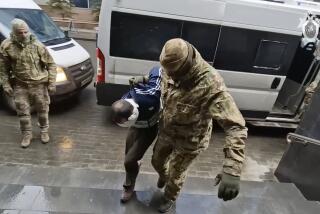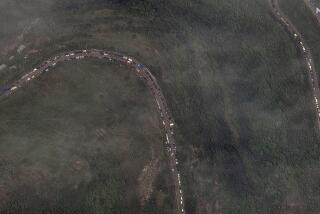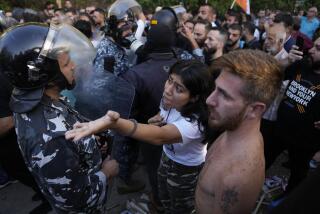Ethnic Russians Wary as Asian Population Increases
- Share via
TASHKENT, Soviet Union — Young women wearing brightly colored head scarves, some carrying infants and others leading toddlers by the hand, are a common sight in Tashkent, the capital of Uzbekistan.
Indeed, children seem to be everywhere in the narrow, curving lanes of the city’s adobe-walled Old Quarter. The average family has three or four children, and some have as many as 12. “Uzbek people love children,” a young mother said, with pride in her voice.
But surging birthrates in Central Asia have contributed to a labor surplus--and to a potential threat to the ethnic Russians who have long dominated the Soviet Union. The Central Asians’ growing numbers, their resentment of the authorities in far-off Moscow and the continuing influence of Islam here, 70 years after the beginning of the atheist Soviet state, are thought to concern Soviet leader Mikhail S. Gorbachev.
In recent years, the population of the five Central Asian republics--Uzbekistan, Kirghizia, Turkmenia, Tadzhikistan and Kazakhstan--has increased faster than any other area in the Soviet Union. And the Central Asians have been reluctant to move to areas in the north and east where labor is in short supply and jobs are more plentiful.
Disparate Birthrates
If the trend continues, Central Asians with a tradition of Islam will represent 20% of the Soviet population by the year 2000. Russians, whose birthrate has declined sharply in recent years, will account for less than 50% of the total by then. Nonetheless, Slavic peoples, including Ukrainians and Byelorussians as well as Russians, will continue to comprise a majority of the population, which is expected to surpass 300 million by 2000.
Despite their numbers, the Central Asians have had no representative on the ruling Politburo since the removal last December of Dinmukhamed A. Kunayev, the former Communist Party boss in Kazakhstan.
Riots erupted in Alma Ata, the capital of Kazakhstan, when Kunayev was replaced as the republic’s first party secretary by Gennady V. Kolbin, an ethnic Russian installed on orders from Moscow.
Nationalist Riots
In what was one of the most violent protests in recent Soviet history, at least 3,000 Kazakhs, driven by nationalist feelings, set fire to buildings and cars. Two fatalities were reported.
Kunayev and his associates have been accused of corruption, nepotism and cronyism in running Kazakhstan’s affairs, charges that also have been directed against the leaders of other Central Asian republics.
According to Western analysts, the explosive protest in Alma Ata reflected underlying tension in relations between national groups and the predominantly Russian authorities concentrated in Moscow.
Signs of resentment against Russian rule also have appeared recently in the Baltic states of Estonia, Latvia and Lithuania, where Western European influence is strong. But the relative isolation of the Baltic states, together with the fact that their combined population is just 10 million, makes them less of a threat to Soviet cohesion.
The population of the Central Asian republics now totals 43 million, according to the 1979 census, and some experts estimate that this number will rise to 64 million by the end of the century.
Population Up 13.7%
In Uzbekistan, the most populous of the Central Asian republics, the population increased by 13.7% in the five-year period ending in 1984. The rate of increase for the Russian republic, by contrast, was 3.3%.
The Central Asians’ common Islamic heritage tends to unite them despite the Kremlin’s efforts to discourage the practice of religion and to limit the number of mosques and mullahs, or religious leaders.
Gorbachev, on a visit to Tashkent a year ago, called for a “firm and uncompromising struggle against religious phenomena.” He criticized Communist Party members in Central Asia for taking part in Islamic weddings, funerals and other religious ceremonies.
Before the Bolshevik Revolution of 1917, there were 26,000 mosques and more than 100 Islamic seminaries with 5,000 students in the region. Today, there are just 1,330 mosques and only one Islamic seminary, with 100 graduates a year. Copies of the Koran, the Muslims’ holy book, are scarce.
Islamic Influence Scored
Nonetheless, Pravda Vostoka, the party newspaper in Tashkent, said last year that Islamic influence was still too strong, even among the intelligentsia.
“In this part of the country, almost all people go to the mosque and pray,” Natasha Sergeeva, an editor with the International Religious Board for Central Asia and Kazakhstan, said recently.
The board has its headquarters in what used to be a medresseh, or Muslim school. According to Sergeeva, Muslim weddings are very popular, and funerals usually are held at the mosque, with readings from the Koran.
According to a Western diplomatic source, “religion and nationalism have always been closely linked in Russia, and religion plays a role in the growing national and cultural self-assertion that is evident in the predominantly Muslim republics.”
Perhaps equally disturbing to Soviet leaders is the tradition of corruption in Central Asia. While Kremlin leaders enjoy trappings such as the dachas and private automobiles that accompany their rank, in Central Asia state wealth has been converted into private fortunes for some party leaders.
Non-Existent Cotton
An example was the cotton scandal in Uzbekistan, where officials of the republic consistently inflated the size of the crop, on paper, and Moscow annually paid for 900,000 tons of cotton that did not exist.
In the Kremlin-directed cleanup that followed, at least 3,000 employees of the republic were dismissed, including 80% of the Uzbek party Central Committee.
The late Uzbek party chief, Sharaf Rashidov, was stripped of state honors in 1986, three years after his death. He was accused of allowing corruption to develop on a vast scale during his 24 years in power.
There were charges that Uzbek officials spent millions of rubles on their offices, on mansions with crystal chandeliers and private swimming pools, while neglecting the need for hospitals, schools and other public facilities.
Yet questions about corruption here are received with a shrug in the tea houses where Uzbek men in hand-embroidered black skullcaps gather to sip green tea and talk for hours on end.
Gold and Jewels
“Leaders always live better than ordinary people, and this is true in all societies,” a Tashkent resident said, reacting to reports that the late Uzbek party boss Rashidov had stashed away huge amounts of gold and jewels.
For Tashkent, once a stop on the old Silk Road from China to the Mediterranean, tales of Oriental despotism and avarice are 2,000 years old.
When Leonid I. Brezhnev was the Soviet leader, authorities in Moscow reflected his live-and-let-live attitude toward provincial chiefs who might veer from the straight and narrow.
But, under Gorbachev, a crackdown on corruption appears likely to continue, as the ouster of Kunayev in Kazakhstan indicates. Gorbachev’s aides have not hesitated to place ethnic Russians in key posts in the Islamic republics in order to break up family networks that have put material gain above Marxist ideals.
Gorbachev has yet to show how he will deal with the political aspirations of the Central Asians for a voice in the top policy-making body of the Soviet Union, the Politburo.
More to Read
Sign up for Essential California
The most important California stories and recommendations in your inbox every morning.
You may occasionally receive promotional content from the Los Angeles Times.













